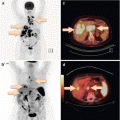© Springer International Publishing Switzerland 2016
Alwin Krämer and Harald Löffler (eds.)Cancer of Unknown Primary10.1007/978-3-319-22581-4_11. Introduction
(1)
Clinical Cooperation Unit Molecular Hematology/Oncology, German Cancer Research Center (DKFZ) and University of Heidelberg, Heidelberg, Germany
Keywords
Cancer of unknown primaryCUPCarcinomaUndifferentiated tumor1.1 Defining Cancer of Unknown Primary
Cancer of unknown primary (CUP) usually refers to histologically proven cancer where no primary lesion has been detected although the initial diagnostic work-up has been completed. The label “CUP” should not be used when a metastatic lesion has been found but an appropriate search for a primary origin has not yet been done. This is already the first problem with the definition of CUP, since it is not exactly defined what the minimum requirements with respect to an appropriate staging are. Indeed, CUP nowadays accounts for 2–3 % of all cancer-related deaths in Germany [1], while older publications state the proportion of CUP to be 5–10 % of all cancers [2], with this likely being the result of improved diagnostic possibilities to identify the primary.
Malignant lesions of non-epithelial origin such as lymphomas and sarcomas must not be categorized as CUP, meaning that CUP usually refers to an epithelial origin. On the other hand, undifferentiated tumors with unknown primary and no signs of any differentiation – neither epithelial nor non-epithelial – are compatible with the definition of CUP, simply because there is no other meaningful category. This delineation is also somewhat problematic, since the assignment of epithelial versus non-epithelial origin depends on the diagnostic methodology used: It can safely be assumed that the “undifferentiated tumor” category has lost ground over the past, say, 30 years due to the improved repertoire of immunohistochemistry, and site-of-origin assignment by gene expression profiling and related techniques may bring this category on the verge of extinction.
Thirdly, the definition of “no primary” is far from being always clear. There are CUP cases with multiple, more or less equally advanced metastases, but others show a leading lesion or a solitary one, and here the question may arise whether the leading or solitary lesion is in fact the primary. Arguments against the notion of the leading lesion being the primary (which, of course, should be default) may include the presence of more than one possible assignment, e.g., an adenocarcinoma within the liver which could be intrahepatic cholangiocarcinoma as well as a metastasis from an unknown primary [3], or a histology clearly arguing against the clinically suspected origin, e.g., if a CT scan suggests nodal-positive lung cancer but histology suggests intestinal adenocarcinoma in the absence of an intestinal lesion. In such cases, primary lesions showing atypical or rare histologic features should be always considered. For example, when a solitary skin lesion with a histology suggestive of adenocarcinoma but no systemic involvement is found, primary adnexal carcinoma of the skin must be considered [4].
Stay updated, free articles. Join our Telegram channel

Full access? Get Clinical Tree







